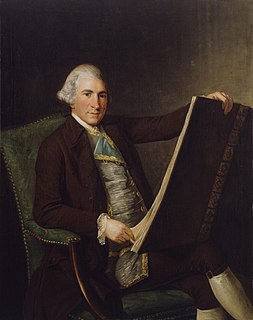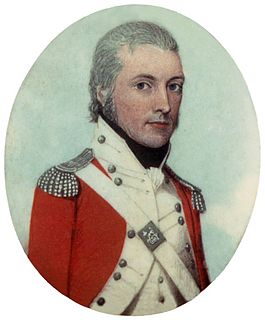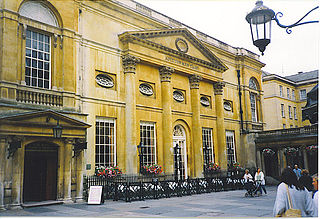
Bath is the largest city in the county of Somerset, England, known for and named after its Roman-built baths. In 2019, the population was 101,106. Bath is in the valley of the River Avon, 97 miles (156 km) west of London and 11 miles (18 km) southeast of Bristol. The city became a World Heritage Site in 1987, and was later added to the transnational World Heritage Site known as the "Great Spa Towns of Europe" in 2021.

Robert Adam was a British neoclassical architect, interior designer and furniture designer. He was the son of William Adam (1689–1748), Scotland's foremost architect of the time, and trained under him. With his older brother John, Robert took on the family business, which included lucrative work for the Board of Ordnance, after William's death.

John Douglas was a Scottish scholar and Anglican bishop.

Lieutenant General Watkin Tench was a British marine officer who is best known for publishing two books describing his experiences in the First Fleet, which established the first European settlement in Australia in 1788. His two accounts, Narrative of the Expedition to Botany Bay and Complete Account of the Settlement at Port Jackson provide an account of the arrival and first four years of the colony.

James Wyatt was an English architect, a rival of Robert Adam in the neoclassical and neo-Gothic styles. He was elected to the Royal Academy in 1785 and was its president from 1805 to 1806.

Sir Leslie Patrick Abercrombie was an English town planner. Abercrombie came to prominence in the 1930s and 40s for his urban planning of the cities of Plymouth, Hull, Bath, Edinburgh and Bournemouth, and later for his radical plan to rebuild the post-war City of London.

Charles Bulfinch was an early American architect, and has been regarded by many as the first native-born American to practice architecture as a profession.

George Dance the Younger RA was an English architect and surveyor as well as a portraitist.
Thomas Hardwick (1752–1829) was an English architect and a founding member of the Architects' Club in 1791.

Joseph Michael Gandy (1771–1843) was an English artist, visionary architect and architectural theorist, most noted for his imaginative paintings depicting Sir John Soane's architectural designs. He worked extensively with Soane both as draughtsman and creative partner from 1798 until 1809 when he set up his own practice.
John Pinch was an architect working mainly in the city of Bath, England. He was surveyor to the Pulteney and Darlington estate and responsible for many of the later Georgian buildings in Bath, especially in Bathwick.
John Palmer was an English architect who worked on some of the notable buildings in the city of Bath, Somerset, UK. He succeeded Thomas Baldwin as City Architect in 1792. He died in Bath.
Thomas Baldwin was an English architect in the city of Bath, who was responsible for designing some of Bath's principal Georgian buildings.
William Paty was a British surveyor, architect and mason working mainly in Bristol. He was appointed City Surveyor in 1788. He worked with his father Thomas Paty and brother John Paty.

Willey Reveley (1760–1799) was an 18th-century English architect, born at Newton Underwood near Morpeth, Northumberland. He was a pupil of Sir William Chambers, and was trained at the Royal Academy Schools. In 1781-2 he was employed as assistant clerk of works at Somerset House.

Koča's frontier refers to the Serbian territory established in the Sanjak of Smederevo, Ottoman Empire, during the Austro-Turkish War (1787–1791). The Habsburg-organized Serbian Free Corps, among whom Koča Anđelković was a prominent captain, initially held the central part of the sanjak, between February and September 7, 1788; after the Austrians entered the conflict the territory was expanded and became a Habsburg protectorate under military administration, called Serbia. After the Austrian withdrawal and Treaty of Sistova (1792), the territory was regained by the Ottomans.

The Grand Pump Room is a historic building in the Abbey Church Yard, Bath, Somerset, England. It is adjacent to the Roman Baths and is named for water that is pumped into the room from the baths' hot springs. Visitors can drink the water or have other refreshments while there.
Daniel Harris was an English builder, prison governor, civil engineer, and architect prominent in Oxford.

The following is a timeline of the history of the city of Bath, Somerset, England.
James Maxwell was an officer in the British Marines and member of Australia's First Fleet which established a penal colony in New South Wales in 1788.











